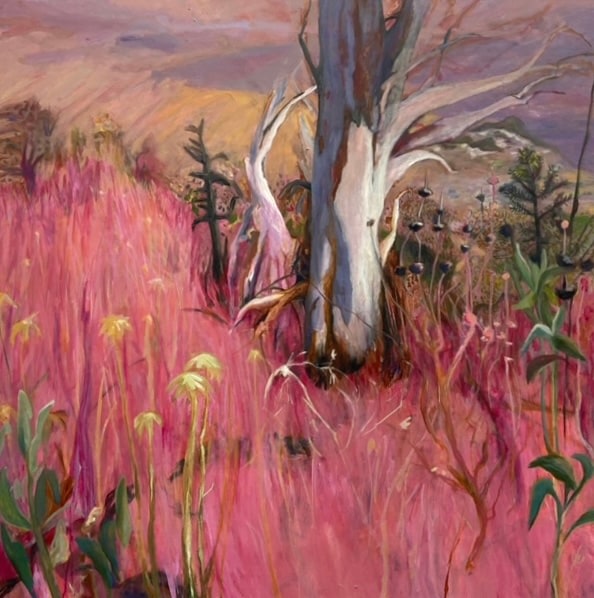What is it to gaze upon a landscape painting, its flora and fauna replicated through memory, perception, and craftsmanship? Painting can be an unmoving vehicle, transporting us to far off places or into our nostalgia. Sydney-based painter Joanna Cole has created a fusion of these experiences. In her newest collection of works, Familiar In The Unfamiliar, Cole asks us to traverse into the beautiful unknown and question our notions of "otherness" in an era of global connectivity.
Presented by Brenda Colahan Fine Art, Cole began this ensemble of vibrant oil paintings while on residency in the south of Spain in 2022. Living and working in the small village of Gaucín, two hours from Picasso's birthplace of Málaga, Cole was immediately grabbed by a strange sensation of reacquaintance despite the new territory. Recognising the presence the European thistles she had known in her youth in rural South Australia, the Spanish landscape felt like home despite its complete novelty. Meanwhile, the sight and smell of Australian eucalypts throughout the Andalucian countryside further blurred the line between foreign and intimate. This limbo shines through in Cole's new works. Through vibrant, textured reds, pinks, and yellows we are brought into the artist's mind's eye and are transported into a hybrid Australian-Spanish landscape.
As Cole skilfully documents in her studio notes during the composition of this collection, both Spaniards and Australians are acutely affected by the legacy of the historical transplanting of thistles and eucalypts in the 19th and 20th centuries. Thistles, prickly and fast-growing throughout the Australian countryside, are often perceived as invasive and disruptive. Similarly, Eucalypts have also found a place in the Spanish landscape, bringing something exotic and unexpected to the Spanish terrain. Alas the imported Eucalypt plays a double role as, a weed, a bushfire hazard, and simultaneously a prolific cash crop and shelter for marching soldiers. The juxtaposition of these foreign elements within the Spanish landscape prompts contemplation about the complex relationship between globalization, colonization, and the reshaping of ecosystems. Cole furthermore challenges our perception of what is considered natural, native, and welcome.
Fitting of the historical period, Cole's expressive style is evocative of the European fauvists and early Australian modernists. Cole's paintings easily sit alongside the works of Paul Gaugin and Vincent van Gogh, friends not only personally but through their deep need to journey for their art. Just as Cole links the first import of plants to present-day ecologies, her strong brushstrokes and strong colour usage rejuvenate expressive landscape painting in contemporary celebration.
And yet Cole is also asking more of us through the wild pigments of these works. While Gaugin painted Polynesia through the lens of an inspired outsider, Cole uses the environment to make us question the very nature of our prejudices. In works such as In and Out of Bounds, Cole presents her juxtapositions with serene contemplation. Reminiscent of Sydney Nolan's depictions of Australian draught during his lifetime, Cole's representations of "local foreign" plant species create windows into the surreality of our current, global-native reality in which life-changing environmental, economic, and interpersonal phenomena traverse locale to connect us and cause what Korean philosopher Byung-Chul Han calls "de-distancing" through culture.
Each painting in The Familiar in the Unfamiliar invites us to challenge our own perceptions, and recognise the commonalities that exist in the in-between spaces of culture, history, and place. As Cole writes in her studio diary, "What is first perceived as a weed - when the history is unlearned and a new history is introduced - becomes a plant with a different, possibly more endearing story, as a staple, a resource, a herb, an object steeped in tradition and culture, and valued." This collection therefore becomes an opportunity to reassess the unknowns we fear, illuminate them with a desire to endear, and appreciate them like a beautiful plant in summer.
Gregory Uzelac
Lecturer, Faculty of Arts and Social Sciences
The University of Sydney

